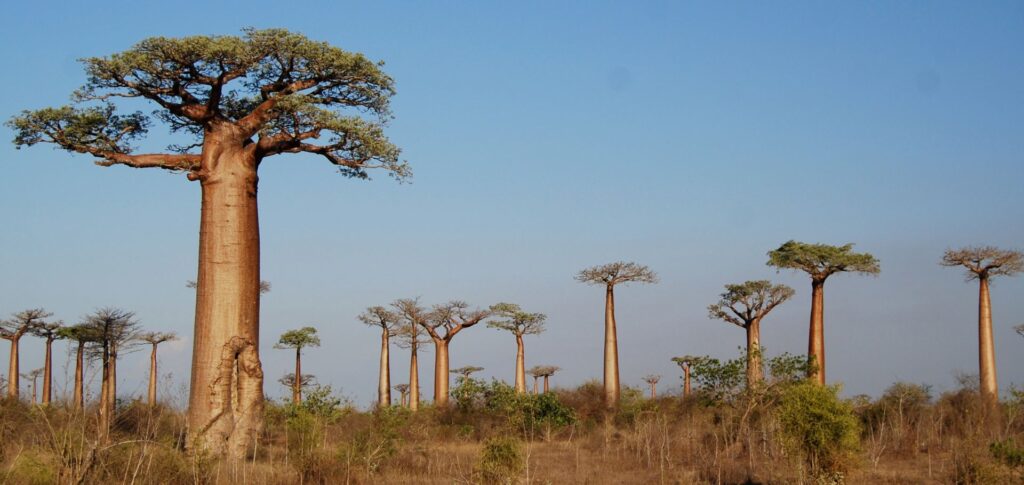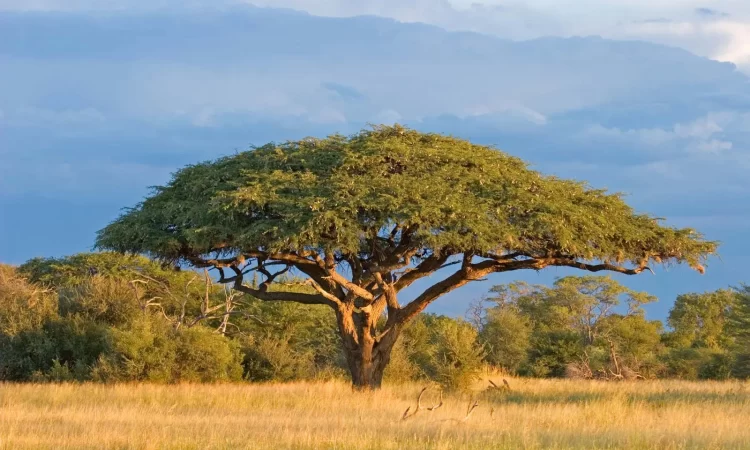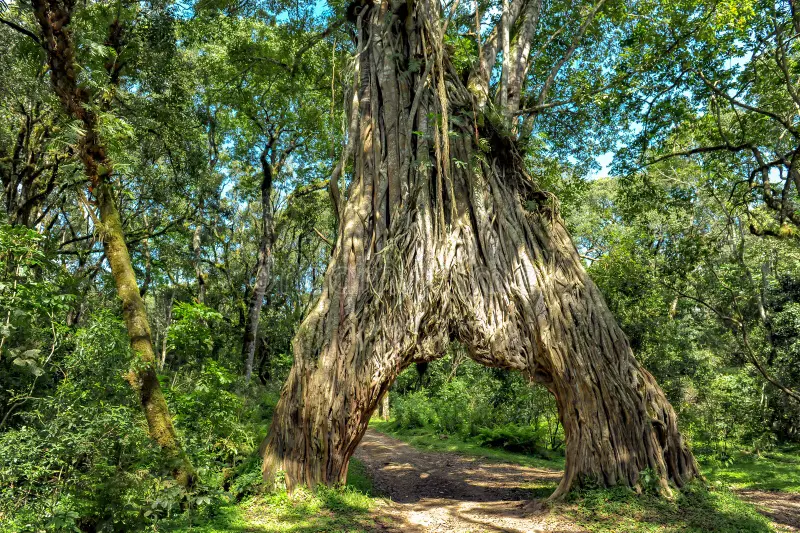Tanzania’s diverse ecosystems, ranging from coastal forests to highland montane environments, support an extraordinary variety of tree species. From the iconic baobab trees of the savanna to the ancient yellowwood forests of the mountains, Tanzanian trees represent millions of years of evolution and adaptation to varied climatic conditions.
The baobab (Adansonia digitata) stands as Tanzania’s most recognizable tree species, earning the nickname “Tree of Life” for its remarkable ability to store water and provide sustenance during dry seasons.
Physical Characteristics:
Distribution in Tanzania: Baobabs thrive throughout Tanzania’s dry regions, with spectacular concentrations in:
Cultural and Economic Importance: Local communities utilize every part of the baobab tree – bark for fiber, leaves for food, fruit for nutrition, and trunk cavities for water storage. The tree holds spiritual significance in many Tanzanian cultures.

Tanzania hosts numerous acacia species, each adapted to specific ecological niches:
Umbrella Thorn Acacia (Vachellia tortilis) The quintessential African savanna tree, creating the classic flat-topped silhouette synonymous with East Africa.
Characteristics:
Fever Tree (Vachellia xanthophloea) Named for its distinctive yellow-green bark and association with fever-inducing mosquitoes in swampy areas.
Key Features:
Sweet Thorn Acacia (Vachellia karroo) A hardy species producing fragrant yellow flowers and nutritious pods.

Fig trees play crucial ecological roles throughout Tanzania:
Sycamore Fig (Ficus sycamorus) Massive trees growing along riverbanks and in moist areas.
Strangler Fig (Ficus species) These fascinating trees begin life as epiphytes, eventually strangling their host trees while creating important wildlife habitats.
Rock Fig (Ficus ingens) Specialized species growing in rocky outcrops and cliff faces throughout Tanzania.
Ecological Importance:

Tanzania’s mountain forests contain some of East Africa’s most impressive trees:
East African Yellowwood (Afrocarpus gracilior)
Ancient coniferous trees found in highland forests, some specimens over 500 years old.
Features:
Podo (Podocarpus latifolius)
Another coniferous species forming the backbone of montane forests.
Red Stinkwood (Prunus africana)
A valuable medicinal tree found in highland forests:
Tanzania’s coastal forests harbor unique tree species adapted to marine influences:
Mkongo (Afzelia quanzensis) A valuable hardwood tree producing beautiful timber:
Mangrove Species Tanzania’s coastline supports extensive mangrove forests:
Red Mangrove (Rhizophora mucronata):
Black Mangrove (Avicennia marina):
White Mangrove (Xylocarpus granatum):
The miombo woodland ecosystem covers much of Tanzania, dominated by:
Brachystegia Species (Miombo) These leguminous trees create Tanzania’s most extensive woodland type:
Characteristics:
Julbernardia globiflora Another key miombo species, often growing alongside Brachystegia:
Sausage Tree (Kigelia africana) One of Tanzania’s most distinctive trees:
Notable Features:
Date Palm (Phoenix reclinata) Wild date palms growing near water sources:
Cedar (Juniperus procera) East African pencil cedar found in highland areas:
Hagenia (Hagenia abyssinica) Distinctive highland tree with medicinal properties:
Mpingo (Dalbergia melanoxylon) African blackwood, one of the world’s most valuable timber species:
Characteristics:
Mvule (Milicia excelsa) East African teak, a valuable timber tree:
Sacred Trees: Many Tanzanian communities consider certain trees sacred:
Tanzania’s trees face numerous threats:
Deforestation Pressures:
Climate Change Impacts:
Over-exploitation:
Protected Areas:
Reforestation Programs:
Best Places to Experience Tanzania’s Trees:
Baobab Viewing:
Forest Experiences:
Educational Opportunities:
Tanzania’s trees provide enormous economic value:
Timber Industry: Sustainable forestry operations provide construction materials and export income
Non-Timber Forest Products: Fruits, medicines, fibers, and other products support rural livelihoods
Tourism: Tree-based attractions contribute significantly to tourism revenue
Environmental Services: Carbon sequestration, watershed protection, and soil conservation provide invaluable ecosystem services
Tanzania’s trees represent one of the country’s most valuable natural resources, supporting biodiversity, human communities, and economic development while facing significant conservation challenges. Understanding and protecting these magnificent species remains crucial for Tanzania’s sustainable future.
 Book Best Tour Now
Book Best Tour NowWhatsApp us